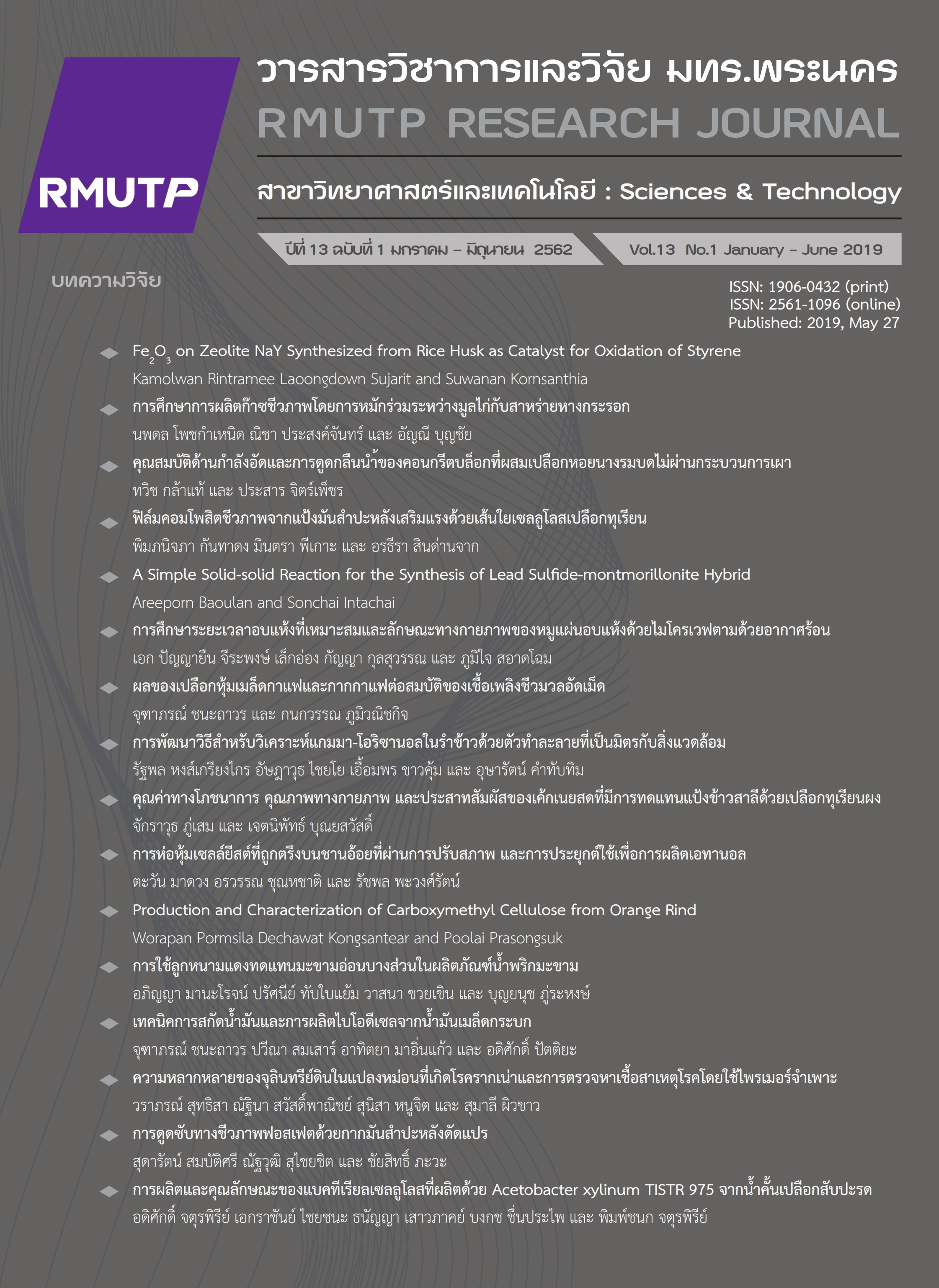Method Development of Gamma-Oryzanol Analysis in Rice Bran with Environmental Friendly Solvent
Main Article Content
Abstract
This research project aim to develop method for analysis of gamma-oryzanol in rice bran with environmental friendly solvent. The total content of gamma-oryzanol in rice bran was investigated using the combination between partial extraction method with ethyl lactate solvent and the study of factors on partial extraction. The parameters that effect the amount of gamma-oryzanol with partial extraction method consist of weight of rice bran, volume of solvent and extraction time were conducted. The result shown the maximum content of gamma-oryzanol that extracted with 50 milligrams of rice bran, 5 milliliters of ethyl lactate and 2 minutes of extraction time. The quantity of gamma-oryzanol in rice bran that observed using partial extraction method with ethyl lactate solvent and classical extraction method were 4.23 and 4.32 milligram per gram rice bran, respectively. The results from both extraction methods were well agreement. When the extracted rice bran was separated with High Performance Liquid Chromatography, the result shown the main compositions of extracted rice bran including cycloartenyl ferulate, 24-Methylene cycloartanyl ferulate and campestanyl ferulate. The develop method for analysis of gamma-oryzanol in rice bran using partial extraction with ethyl lactate solvent is easy, use only small apparatus in laboratory, cheap, short-time consuming and use environmental friendly solvent.
Article Details
References
[2] M. Patel and S. Naik, “Gamma-Oryzanol from rice bran oil-A review,” J. Sci. Ind. Res., vol. 63, pp. 569–578, Jul. 2004.
[3] P. Kumar et al., “Comparative study on conventional, ultrasonication and microwave assisted extraction of -oryzanol from rice bran,” J. Food Sci. Technol., vol. 53, no. 4, pp. 2047–2053, Apr. 2016.
[4] A. Proctor and D. J. Bowen, “Ambient-temperature extraction of rice bran oil with hexane and isopropanol,” J. Am. Oil Chem. Soc., vol. 73, no. 6, pp. 811–813, Jun. 1996.
[5] W. Hu, J. H. Wells, T.-S. Shin, and J. S. Godber, “Comparison of isopropanol and hexane for extraction of vitamin E and oryzanols from stabilized rice bran,” J. Am. Oil Chem. Soc., vol. 73, no. 12, pp. 1653–1656, Dec. 1996.
[6] C. S. M. Pereira, V. M. T. M. Silva, and A. E. Rodrigues, “Ethyl lactate as a solvent: Properties, applications and production processes – a review,” Green Chem., vol. 13, no. 10, pp. 2658–2671, Jan. 2011.
[7] R. Bucci, A. D. Magrì, A. L. Magrì, and F. Marini, “Comparison of three spectrophotometric methods for the determination of -oryzanol in rice bran oil,” Anal. Bioanal. Chem., vol. 375, no. 8, pp. 1254–1259, Apr. 2003.
[8] B. Shammugasamy, Y. Ramakrishnan, F. Manan, and K. Muhammad, “Rapid Reversed-Phase Chromatographic Method for Determination of Eight Vitamin E Isomers and -Oryzanols in Rice Bran and Rice Bran Oil,” Food Anal. Methods, vol. 8, no. 3, pp. 649–655, Mar. 2015.
[9] S. Lilitchan, C. Tangprawat, K. Aryusuk, S. Krisnangkura, S. Chokmoh, and K. Krisnangkura, “Partial extraction method for the rapid analysis of total lipids and -oryzanol contents in rice bran,” Food Chem., vol. 106, no. 2, pp. 752–759, 2008.
[10] Cholticha Tangprawat, “Determination of total lipid content and gamma-oryzanol in rice bran,” Mahidol university, 2006.
[11] S. Iqbal, M. I. Bhanger, and F. Anwar, “Antioxidant properties and components of some commercially available varieties of rice bran in Pakistan,” Food Chem., vol. 93, no. 2, pp. 265–272, Nov. 2005.
[12] M.-H. Chen and C. J. Bergman, “A rapid procedure for analysing rice bran tocopherol, tocotrienol and -oryzanol contents,” J. Food Compos. Anal., vol. 18, no. 2–3, pp. 139–151, 2005.


